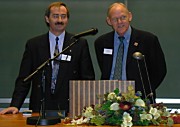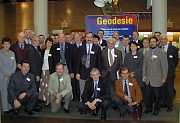

FIG Task Force on Mutual Recognition of Qualifications
|
By Stig Enemark, Chair of the FIG Task Force on Mutual Recognition
 |
Paddy Prendergast, President of the Council of European
Geodetic Surveyors (CLGE) and Professor Stig Enemark, Chair of the FIG Task
Force on Mutual Recognition at the first joint CLGE/FIG Seminar in Delft,
November 2000. |
A joint FIG/CLGE seminar on Enhancing Professional Competence was held 3 November at Delft University of Technology in the Netherlands. The aim of the seminar was to develop a suitable framework for the surveying profession in Europe as a basis for enhancing professional competence through the principle of mutual recognition of professional qualifications which has been established in law at the European level. This is the first joint activity to combine the efforts of FIG and CLGE (The Council of European Geodetic Surveyors). The seminar was by invitation only and attracted some 50 participants from 17 countries representing the educational sector and the professional surveying community in the European region.
The general EU Directive on the mutual recognition of professional qualifications established the concept of a BAC + 3 (BSc) level of higher education as a basic criteria for the exchange of professionals between EU member states. This concept of mutual recognition and the legal framework imposed by the EU's Directive has resulted in some difficulties of implementation at national level. The EU Directive is currently under review but the host organisations recognise the broad principles on which mutual recognition should be based. These three principles are:
The seminar aimed to develop a concept based on these three principles and suitable for the surveying profession in Europe. The seminar was focused on three issues:
The seminar is part of an on-going process of investigation and debate within both the CLGE and FIG. In 1998, FIG established a task force on the mutual recognition of professional qualifications and the CLGE established a working party on a core syllabus. FIG and CLGE decided to collaborate on the project in 2000, and CLGE awarded two research grants to provide:
Specifically, the intention of this seminar was to widen the debate among the academic surveying community in Europe and to elicit their opinions and ideas.
The seminar was jointly organised by the CLGE President, Paddy Prendergast and the Chair of the FIG Task Force on Mutual Recognition, Prof. Stig Enemark. The sessions were chaired by Prof. Kirsi Virrantaus, the current chair of FIG Commission 2.
In the introduction Paddy Prendergast discussed some of the main influences on surveying education, which include the changing commercial environment and the intensive application of technology in surveying. He stated that the surveying education in Europe is still focused on national markets, and that changes are needed to prepare for new international markets at regional and global levels. CLGE has been involved in research into the varied nature of surveying within Europe, as demonstrated by the Allan Report (http://www.ge.ucl.ac.uk/clge/allan_report/). Stig Enemark described the seminar as paving the way for professional competence in Europe, which is a goal shared by both the CLGE and FIG. He discussed the changes in the profession within Europe and in employment patterns and emphasised that "the only constant is change". In such a dynamic professional environment, the educational base must be flexible and interdisciplinary, and the graduates must be adaptable to cope with these future changes. University graduation should therefore be seen as only the first step in a lifelong educational carrier.
Dr. Frances Plimmer from the University of Glamorgan gave a presentation, which outlined the methodology applied by the EU Directive to the process of achieving the mutual recognition of professional qualifications. She explained that the directive does not directly affect employment or the process of licensing surveyors; it only gives surveyors from another EU country the right to have their professional qualifications treated as equivalent to those acquired by the nationals from any other EU country. The process of becoming "qualified" varies throughout Europe. In some countries, it is merely by holding an academic qualification that a surveyor is "qualified", although to undertake certain surveying tasks, it is also necessary to become licensed, a process often controlled by the state. In other countries, there are sub-state private organisations, which regulate both education and professional qualifications. The delegates at the seminar agreed to contribute further detailed information in this area. One of the outcomes of the ongoing research will be to identify and publicise the different national models for becoming a "qualified" surveyor in Europe. This should improve the understanding of the processes and thereby enable appropriate organisations to administer the terms of the mutual recognition directive effectively within the field of surveying.
Rob Ledger from the Royal Institution of Chartered Surveyors described the CLGE project to identify a core syllabus. The aim was to raise the baseline quality of surveying education and also improve the mobility of surveyors in practice. He outlined the problems of listing common subjects in all EU universities to create a core syllabus. These problems relate to market diversity and cultures. Course content is based on market requirements and academic institutions are concerned to equip students to meet market needs. Also, the definition of a "surveyor" does not always reflect the nature and activities of "surveying" in a given market; and professional work varies in different countries according to the way professions have developed over time in different European countries. In terms of educational policies there is an input/output debate, with the "input" basis concentrating on topics and hours studied; whereas the "output" focused on the competencies of the graduates who leave universities. Professional course assessment models ranged from self-assessment to accreditation. The inter-relationship between education, industry, profession and government is very different throughout Europe. All this diversity has an implication for a core syllabus. The profession, instead, needs to understand and provide information on different competency and educational models that have been successful in meeting evolving market needs.
Professor Hans Mattsson from the Royal Institute of Technology, Stockholm presented his ongoing research on surveying curricula in Europe. His analysis is based on the Allan Report providing information on the educational programmes and the professional duties of land surveyors in the European countries. Despite some identified drawbacks in the methodology of this report the information was used to identify different models for curricula content compared to professional practice. The analysis also included comparison of the university course structures in Sweden, Spain, Germany, Denmark and Ireland on the basis of subject content and hours studied. Some European countries have a "broad" surveying profession (e.g. the Nordic countries), while others have a more "narrow" profession. He identified the dichotomy of a narrow education and a broad profession and discussed how professional education could be changed and who should guide such changes. Professor Mattsson considered that the differences in university curricula models provide a valuable source of information for universities to learn from each other and to expand and develop the professional education they offer. He concluded that it would be valuable within Europe to develop academic teaching networks for surveying schools in parallel with professional networks.
It seems evident from the debate at the seminar that "the only constant is change" and that we must continue to ensure that our graduates are educated for a changing profession in a changing market. It is important to provide future surveyors with the necessary professional education and training and the administrative procedures to work anywhere in Europe. While our marketplace is, currently, Europe, there is a clear indication from the World Trade Organisation, that the marketplace will soon be global.
There was a clear indication of a future educational profile composed by the areas of Measurement Science and Land Administration and supported by and embedding in a broad interdisciplinary paradigm of Geographic Information Management. There was also a clear indication that a better understanding of different educational and competence models can establish a general improvement of the educational base and enhancement of professional competence in the broad surveying discipline throughout Europe and also at a more global scale.
The proceedings from the seminar including the final research papers, discussions and recommendations will be available from the FIG office around April 2000. The background papers are available on the home page of the Task force on Mutual Recognition (http://www.ddl.org/figtree/tf/mut-recog/index.htm).
 |
Participants to the first CLGE-FIG Seminar on Enhancing Professional Competence in Delft. |